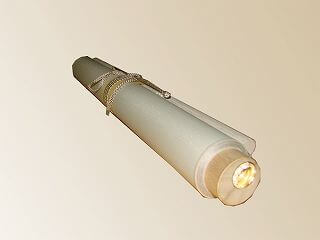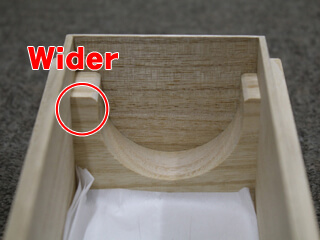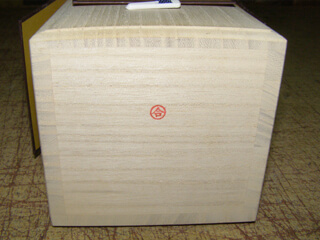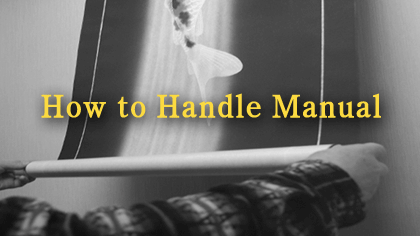Lesson
News / Blog
Other Menus
Tools to Preserve Kakejiku (Hanging Scrolls) More Carefully
Nijuubako (Double-structured Paulownia Box) / Futomaki (Roller Clamp)
A “nijūbako” (a double-structured paulownia box) is sometimes used to preserve a kakejiku more carefully. The outer box is a big, lacquered, paulownia box. This preserves a kakejiku more strongly, and shields it better from humidity and dryness.
A “futomaki” (roller clamp) is also sometimes used to preserve a kakejiku more carefully. It is a large roller rod used to cover the already-attached roller rod when rolling a kakejiku. By making the diameter of the roller rod bigger, creasing, distortion, and other forms of tension on the main work can be prevented.
These may be used together, or independently.
Download PDF: Nijūbako (Double-structured Paulownia Box) / Futomaki (Roller Clamp)
(Updated: 20190409)
How to use in displaying

Start.

Take the nijūbako (double-structured paulownia box) out of the “tatōshi” (paper box).

Open the outer box, and take out the inner paulownia box which contains the “kakejiku” (hanging scroll).

Open the inner paulownia box.

This is the futomaki (roller clamp).

Open the kakejiku slowly.


Open and remove the futomaki (roller clamp).

End.
How to properly store

Open a futomaki (roller clamp), rest the roller rod (Jikubō/軸棒) inside and close.


Ensure that the front/back direction of the futomaki is correct.
There are two parallel cuts running through one side of the futomaki and these heights are slightly different. Be sure to set a higher edge at the rear of a hanging scroll, and a shorter edge in front of you. Check if the futomaki fully covers the roller rod and roller ends (Jikusaki/軸先) then start rolling up.

Roll up the kakejiku.


Inside a paulownia wooden box, there are small wooden pieces on both ends. These are what we call the “pillow” for a hanging scroll (Makura/枕). Taking a closer look, you will notice they are slightly different widths. When storing the scroll in the box, make sure to position the hanging rod (Hassou/八双) beside the wider wooden pieces(枕). Also, the hanging cord(Jikuhimo/軸紐) must face upward. Otherwise, the scroll won’t fit perfectly in the box.

This is the way how the scroll should look like in the wooden box.

Close the paulownia box.

To make sure the paulownia wooden box and its lid are always placed in the same direction, we have stamped a Chinese character “合”(stands for “fit”) on them as shown in the picture. Please follow this sign when closing the box. In case they are put in the opposite direction, the box won’t close properly. Even if it could be closed, it gets difficult to open the box, especially when the wood swells due to high humidity.

Put the paulownia box into the outer lacquered box.

Close the outer box, and put the nijūbako into the “tatōshi” (paper box). Ensure that the vertical/horizontal direction of the paulownia box and the nijūbako are correct.

End
Of course, you can buy only nijūbako or futomaki + kiribako set. Please contact us.
Contents Link
 How to Handlethe Kakejiku How to Handlethe Kakejiku |

